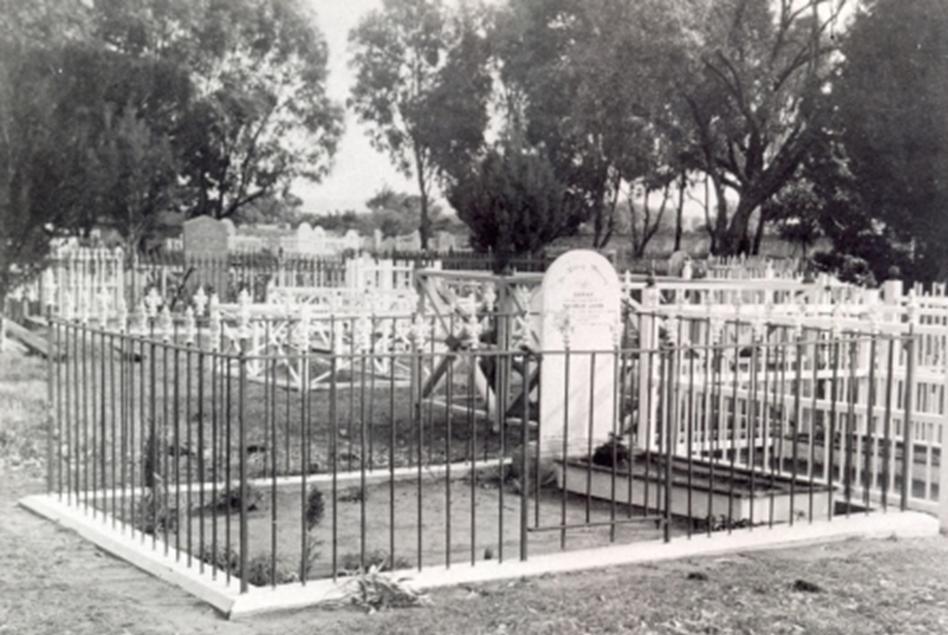

Freotopia > cemeteries >
The Skinner Street Cemetery was in operation 1852-1899, bounded by East and Vale Streets, which still exist, Park Street, later closed, and an extension of Skinner Street which was never built (and is now a back road into the rear of John Curtin school)—but is the reason for the name of cemetery. The main entrance was from Skinner Street. (Vale Street might have been a better name for the cemetery, as not only did it run along its longest side but also 'vale' means 'farewell' in Latin. Might it be the origin of the street's name?)

The map shows the cemetery divided into various sections by religion or denomination. The largest, C1, is the original Anglican section; the westernmost section, C5, was later added to the C of E section. At the eastern end C4 was the original Catholic section, to which C7 was later added. This had its own name, St Patrick's Cemetery, and its own entrance, through iron gates from East Street - where the easternmost edge of C7 is shown on the map. Where this entrance was there is now a stone memorial called the Eastern Gates Lookout (photograph below). See the plaque photographed below for more details.
The oldest tombstone in the cemetery is that of a man who died 7 October 1852, so the cemetery was in use by that date, tho it may have opened earlier in 1852. (See the article in the West Australian below.) The last funeral was that of Johanna Duggan, aged 17, of Tuckfield St, in 1923. There were more than 800 interments. Almost all of the remains are still where they were buried.
The former Cemetery is now the sports field of the John Curtin College of the Arts (formerly High School). What is shown on the map as Public Park was excised from Fremantle Park for the construction of the School in 1956 (tho the land had notionally been set aside for that purpose as early as 1917). The western boundary of the school is roughly where 'Skinner Street' is shown above, extended due south.
In 1931 some ninety headstones were moved from Skinner Street and relocated to Fremantle Cemetery. There are actually 135 memorials on the Heritage Trail in the newer cemetery. The Act of Parliament to do with the closure is available online here.

The City of Fremantle has stated in Facebook that this photograph of the Skinner St Cemetery was taken 1905-17, and that the headstone is that of Sarah John nee Woodland (1835-1884) in the Church of England section. It is Fremantle Library image #3372, c. 1911.
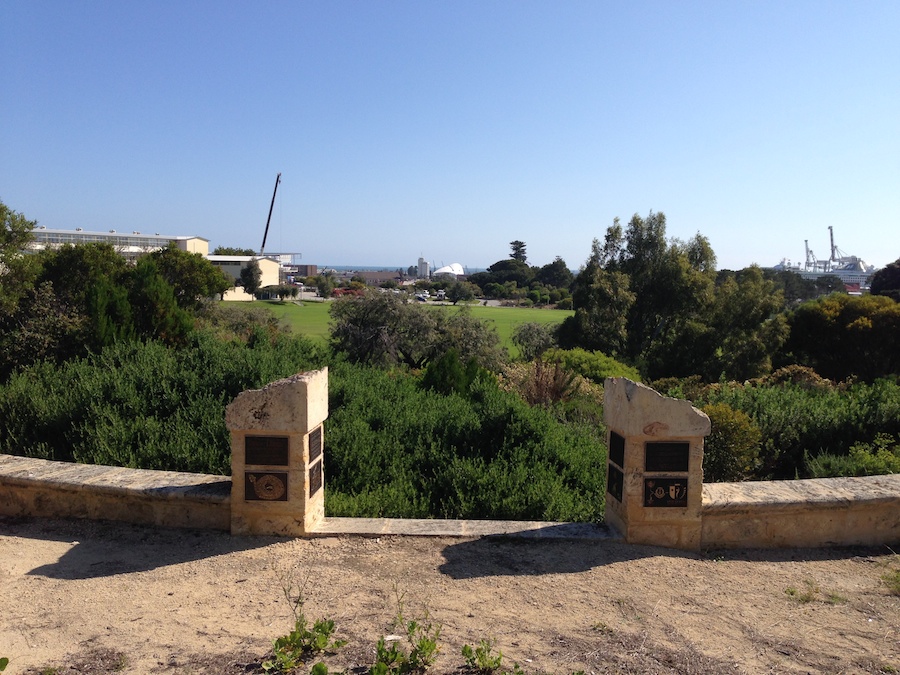
The 'Eastern Gates Lookout', above the former Skinner St Cemetery: iron gates once stood here leading to the Roman Catholic section - which was known as St Patrick's Cemetery. The memorial was opened Wednesday 8 June 2005 in a ceremony in the John Curtin grounds. My snap.
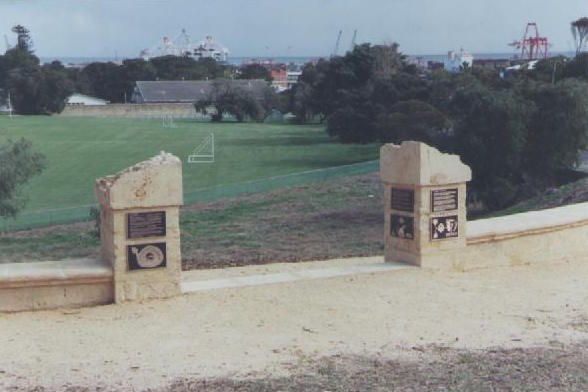
The Eastern Gates memorial when first installed in 2005: rather less overgrown. Thanks to Margaret Baddeley for the photograph.
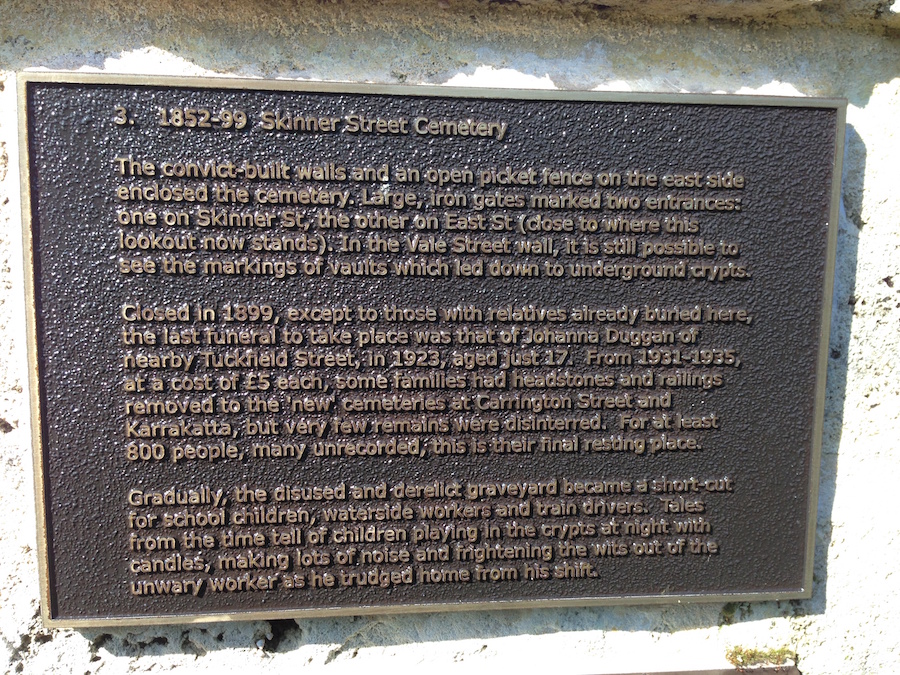
The West Australian, Thursday 19 September 1935, page 9.
EARLY FREMANTLE.
RECORD OF DEATHS.
Interesting Book Discovered.
Recently discovered in the vestry of St. John's Church, Fremantle, was an old record book of funerals conducted in the Fremantle parish from 1860 to the end of 1874. The entries in the register are of particular interest just now when a Bill has been passed by Parliament to delete a provision in the existing Act and provide for the removal of the remains of persons buried in the cemetery so that the Fremantle City Council might remove the headstones and prevent wanton destruction by having them re-erected in the Fremantle cemetery. Probably the majority of the people whose names are entered in the old register were buried in the Skinner-street cemetery, which was dedicated in 1852 and continued to be used until the opening of the present burial ground in 1899. The first recognised cemetery in Fremantle was the old ground in Alma-street, which was opened in 1831 and used for 20 years. The first grave to be marked by a headstone in Alma-street appeared to be that of Mrs. Mary Ann Morrell, who died on October 8, 1832. The oldest tombstone in the Skinner-street cemetery was erected to Lieutenant Edward Colvin Oakes, of the 28th Bengal Infantry, who died on October 7, 1852. The first entry in St. John's church register records William Sutcliffe, aged one year, who died on January 19, 1860. The clergyman who officiated at the burial service was the Rev. George James Bostock, who, from 1850 to 1874, was a conspicuous figure in the life of the colony, Mr. Bostock lived in Cantonment-street in St. John's church rectory, which was demolished eight years ago. The last entry in the book under Mr. Bostock's name is dated December 16, 1874. Later appear several different signatures, including "Matthew, Perth," that of the first Anglican Bishop of Western Australia, Bishop Hale.
Child Mortality.
Although the register deals only with a portion of the deaths from 1860 to 1874, it is possible to gain some knowledge of events in the colony. For instance, quite early in the book nine deaths are recorded as due to measles, which indicates at least a mild epidemic of the disease. Then in July, August and September of 1862 five children, the eldest of whom was 12 years of age, died following an attack of fever. Of course, medical facilities in those days were far from good and towards the end of the register, in November, 1874, nine deaths, mainly of young people, are recorded as due to enteric fever. Some idea of the difficulty that must have been experienced in rearing children in those early days may be gained from the fact that of the 328 deaths registered between January 19, 1860, and July 31, 1875, 140 were of children under the age of 12. The majority of those deaths were in early infancy. The entries also provide an impression of the struggle and hardships that were the lot of settlers in a new country. The death is recorded on February 17, 1861, of William Osborne, aged 18, who was killed when a well which he was digging fell in. Other instances are given of men who lost their lives in pioneering work. In several instances the cause of death is given as ''drink." Once Mr. Bostock attributes a man's death to "hard living."
Exciting Days.
Apparently the settlers were not without their days of excitement. On May 11, 1864, the death is noted of an old man discovered with his neck broken near the North Fremantle ferry. Three days later a 15-year-old lad was found hanged in a barn in Cliff-street. Various instances are recorded of suicide and others of men who had wandered off into the bush and died through exposure. A dramatic entry was made on March 3, 1871, concerning the death of one James Holditch, aged about 60. Mr. Bostock, under the heading "Cause of Death," wrote: "Murdered. Found naked in river. Supposed to have been murdered in bush at North Fremantle."
Seafarers' Deaths.
An interesting entry in the register is the death on March 20, 1868, of Bentley Shepherd, who came out to the colony on the convict ship Hougomont. The arrival of the Hougomont at Fremantle on January 10, 1868, with Fenians on board marked the end of the transportations that had existed for 18 years. The decision of the Imperial Government to send the Fenians to the colony created quite a scare among timid people. Shepherd was apparently a purser's steward on the Hougomont, but he left the ship at Fremantle to become assistant warder. However, his career in the new colony was limited to two months. Three months after the entry concerning Shepherd's death is that of Owen Francis, mate of the Rio, who was stated to have died from the "effects of Mauritius fever." Another seafarer whose death is chronicled is Thomas O'Grady, master of the vessel Dawn. He died of heart disease when leaving the Irwin River on July 26, 1870. There is also an instance of a sailor who had fallen overboard when leaving his ship on a dark night. A number of the people whose names are entered in the register played a prominent part in the early life of the colony or were members of families conspicuous in the settlement. On November 14, 1863, Mary Ann Pengelly died at the age of 72. According to Mr. Bostock's entry, she was the schoolmistress for the infants of the colony. On April 25, 1869, Christopher James Alderson, the infant son of the chaplain of the convict establishment, died, and on May 6 of the same year appears the name Francis Henry Vincent, who is described as "late superintendent at Rottnest." He died at the age of 73. Frederick Lefroy, the infant son of H. Maxwell Lefroy, the superintendent of the convicts, died on February 28, 1870. Although the records do not actually disclose in what cemetery the bodies were buried, it is reasonable to assume that most of them lie in the Skinner-street ground. After the opening of that cemetery the only interments permitted at Alma-street were those of persons who had near relatives buried there. However, towards the end of the register the number is given in some cases of the plot in which the body was buried, so that from the old records the final resting place of some of the State's pioneers may be ascertained.


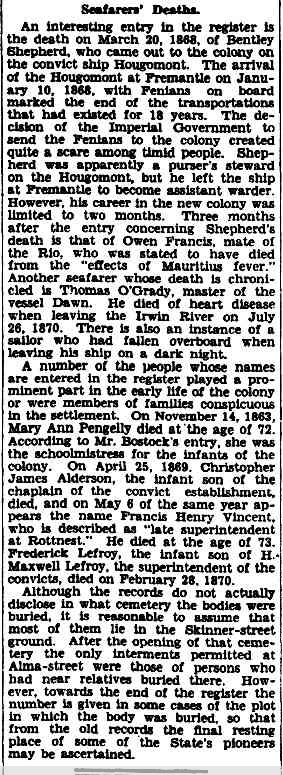

Well done to the Friends of the Eastern Gates Volunteers for their work in restoring the 'lost' Skinner Street Cemetery which had been buried since 1937.
The volunteers have worked tirelessly on this fantastic project for 11 years, through rain, hail, snow and bushfires. They have believed so much in the story that their determination has never wavered.
Without their super efforts, Skinner Street Cemetery would lie forever beneath the green sward of John Curtin College Oval, unremarked and forgotten and all those wonderful 2 000 early settlers with them.
The volunteers have also just completed another long project, in tandem with the cemetery. The last wall standing of the old cemetery has been restored by Italian artisan Piero Casselatti. We now have a marvellous landmark and place of learning and teaching for Fremantle.
Thank you to Lottery West for providing the grant to make this project happen.
Morning tea was held on Monday 28 July 2014 at the City of Fremantle Reception Room.
Visit the City's Facebook page for photos from the morning tea.
Photo (from right to left): Donald Whittington – Metropolitan Cemeteries Board, Wendy Markmann – Leader for the 'Lost' Skinner Street Cemetery restoration project, Stephen Carre – LotteryWest Board member, Alan Kelsall – City of Fremantle Heritage Coordinator, Bevan Bessen – Tuna Blue Pty Ltd Board member not for profit foundation, Dr Brad Pettitt – Fremantle Mayor.


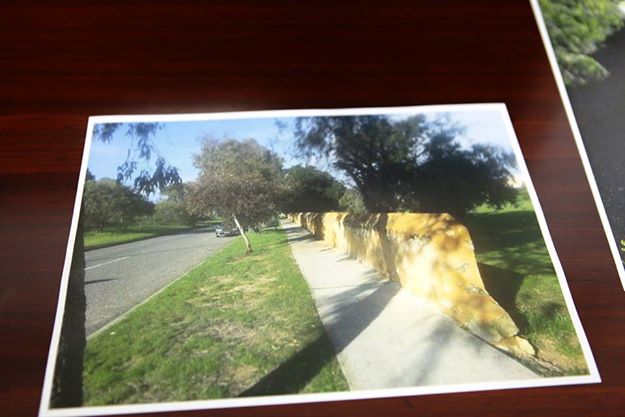

FHS article in the Newsletter for April 2015 about Wendy Shaw Markmann and her involvement with the land where the Skinner Street Cemetery was, and her work in reviving its recognition (pp. 4-6).
Spreadsheet of registers of deceased persons transcribed from church records, mostly related to Alma and Skinner St Cemeteries (Excel doc: xls) - file created by Fremantle Library staff mostly from the Kate Caldwell transcriptions from parish records. The same data as in this PDF (courtesy of the City Library).
Berryman, Ian 1979 ed., A Colony Detailed: The First Census of Western Australia 1832, Creative Research, Perth.